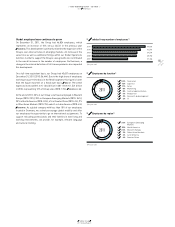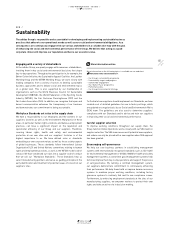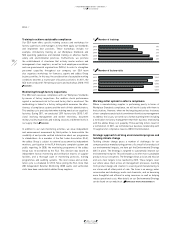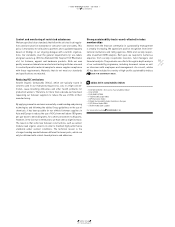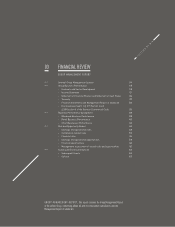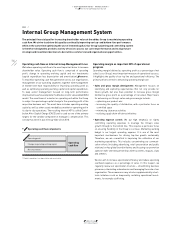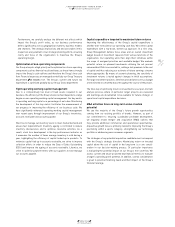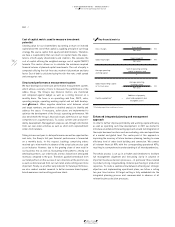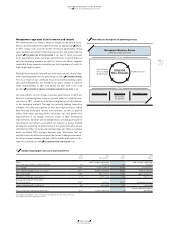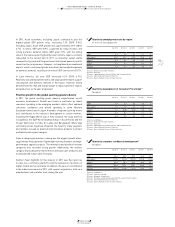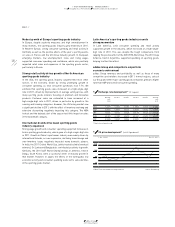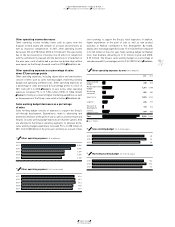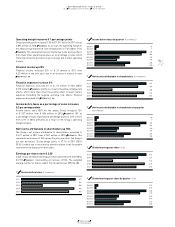Reebok 2011 Annual Report Download - page 119
Download and view the complete annual report
Please find page 119 of the 2011 Reebok annual report below. You can navigate through the pages in the report by either clicking on the pages listed below, or by using the keyword search tool below to find specific information within the annual report.
adidas Group
2011 Annual Report
GROUP MANAGEMENT REPORT – FINANCIAL REVIEW
115
2011
03.1 Internal Group Management System
Furthermore, we carefully analyse the different mix effects which
impact the Group’s profit ratios, as our business performance
differs significantly across geographical markets, business models
and channels. The strategic implications and decisions taken in this
respect are a key element of our strategic planning efforts, ensuring
clarity and focus of the organisation to maximise the Group’s
operating margin.
Optimisation of non-operating components
Our Group also puts a high priority on the optimisation of non-operating
components such as financial result and taxes, as these items strongly
impact the Group’s cash outflows and therefore the Group’s free cash
flow. Financial expenses are managed centrally by our Group Treasury
department
SEE TREASURY, P. 129
. The Group’s current and future tax
expenditure is optimised globally by our Group Taxes department.
Tight operating working capital management
Due to a comparatively low level of fixed assets required in our
business, the efficiency of the Group’s balance sheet depends to a large
degree on our operating working capital management. Our key metric
is operating working capital as a percentage of net sales. Monitoring
the development of this key metric facilitates the measurement of
our progress in improving the efficiency of our business cycle. We
have significantly enhanced operating working capital management
over recent years through improvement of our Group’s inventories,
accounts receivable and accounts payable.
We strive to manage our inventory levels to meet market demand and
ensure fast replenishment. Inventory ageing is controlled to reduce
inventory obsolescence and to optimise clearance activities. As a
result, stock turn development is the key performance indicator as
it measures the number of times average inventory is sold during a
year, highlighting the efficiency of capital locked up in products. To
minimise capital tied up in accounts receivable, we strive to improve
collection efforts in order to reduce the Days of Sales Outstanding
(DSO) and improve the ageing of accounts receivable. Likewise, we
strive to optimise payment terms with our suppliers to best manage
our accounts payable.
Capital expenditure targeted to maximise future returns
Improving the effectiveness of the Group’s capital expenditure is
another lever to maximise our operating cash flow. We control capital
expenditure with a top-down, bottom-up approach. In a first step,
Group Management defines focus areas and an overall investment
budget based on investment requests from various functions of the
organisation. Our operating units then align their initiatives within
the scope of assigned priorities and available budget. We evaluate
potential return on planned investments utilising the net present
value method. Risk is accounted for, adding a risk premium to the cost
of capital and thus reducing our estimate of future earnings streams
where appropriate. By means of scenario planning, the sensitivity of
investment returns is tested against changes in initial assumptions.
For large investment projects, timelines and deviations versus budget
are monitored on a monthly basis throughout the course of the project.
The final step of optimising return on investments is our post-mortem
analysis process, where in particular larger projects are evaluated
and learnings are documented to be available for future strategic or
operational capital expenditure decisions.
M&A activities focus on long-term value creation
potential
We see the majority of the Group’s future growth opportunities
coming from our existing portfolio of brands. However, as part of
our commitment to ensuring sustainable profitable development,
we regularly review merger and acquisition (M&A) options that
may provide additional commercial and operational opportunities.
Acquisitive growth focus is primarily related to improving the Group’s
positioning within a sports category, strengthening our technology
portfolio or addressing new consumer segments.
The strategies of any potential acquisition candidate must correspond
with the Group’s strategic direction. Maximising return on invested
capital above the cost of capital in the long term is a core consid-
eration in our decision-making process. Of particular importance
is evaluating the potential impact on our Group’s free cash flow. We
assess current and future projected key financial metrics to evaluate
a target’s operating profit potential. In addition, careful consideration
is given to potential financing needs and their impact on the Group’s
financial leverage.


